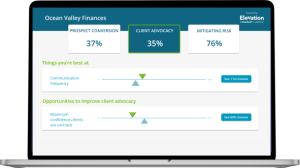In the three months since the Consumer Duty came into effect, many advice firms have started collecting feedback systematically for the first time.
The value of this feedback is huge, both in demonstrating that firms are meeting the Duty, and in identifying opportunities for organic growth.
Based on our conversations with advisers and firms, we’ve identified 5 best practice steps for collecting feedback – and what to do with it.
1. Invite all clients to give feedback
First, invite all your clients to give feedback. “Advice firms who don’t are only cheating themselves”, says Rob Heath, Director of IronMarket Wealth, “It’s only by asking all our members for feedback that we can uncover our blind-spots and identify areas which need improvement”.
After inviting all their clients for feedback, the proportion of IronMarket’s clients who showed an understanding of their fees fell, from 86% to 60%. “That highlighted an important opportunity to give our members a better experience and to reduce the potential for risk within our business,” Heath said.
In response, IronMarket contacted every client whose feedback showed a potential risk, then enhanced their process to proactively check clients’ understanding in annual meetings. As a result, the percentage of their clients who show an understanding of their fees has leapt to 91.43%.

2. Include prospective clients
Prior to the Consumer Duty deadline, many firms didn’t invite prospects to give feedback. This year, with the requirement that firms monitor outcomes for prospective, as well as actual, clients, the proportion that do has more than doubled – but it’s still only 23%.
Firms who’ve adopted this practice have uncovered a significant opportunity.
The difference between a prospect becoming a client or not is a fine line. Elevation data shows that 53% of prospects who give a 5-star first impression review go on to become a client; for those who leave a 4-star first impression review, only 14% do.
Collecting and acting on feedback from prospective clients can increase conversion rates to as much as 71%.
3. Ask the right questions
Arriving at the right questions to ask can be tricky. In part because most people give answers that make their adviser look good. This is encouraging on the one hand, but it doesn’t help improve your client experience.
For example, our Elevation survey used to ask prospective clients the question, ‘Was the adviser clear about their fees?’. 89% said ‘Yes’.
When we changed the question to ‘How do the adviser’s fees work?’ and gave simple multiple choice options, only 44% could give an answer.
Interestingly, when prospective clients are clear how an adviser’s fees work, 51% intend to become clients. This falls to 29% where they are not sure. So, asking the right questions – and acting on the feedback – offers a significant commercial advantage.
4. Use an independent, third-party provider
Some firms are unsure why they should use a third-party provider to execute a feedback survey they could do themselves. Indeed, one firm went so far as to A/B test the benefits.
They split their client base into two groups: one was sent a survey via their internal comms team; the other received the same survey via Elevation.
The survey sent internally received a 5% response rate; Elevation’s survey received 31%.
5. Get the recognition you deserve
Advisers and firms have worked hard this year to focus on improving their client experience.
This shows in the feedback that advisers receive from clients: the average star rating for an adviser on VouchedFor is 4.9 out of 5, and our data shows that 95% of clients would recommend their adviser.
Advisers should be proud of what they’ve achieved, and should be more confident about promoting themselves.
The biggest opportunity for many advisers is simply to ask their clients for recommendations. Amazingly, 80% of clients say they haven’t been asked by their adviser to recommend them to friends and family. But asking your client to recommend you can double the number of recommendations you receive.
The other important step is to share positive feedback publicly, so that prospective clients can see how you can help them, too. 1 in 3 new clients find and read an adviser’s VouchedFor reviews before making contact.
To celebrate the brilliant, often life-changing, work that advisers do for their clients, we’re distributing our 2024 Guide to Top Rated Financial Advisers in The Times, The Telegraph and the Mail on Sunday – reaching more than 3 million consumers.
A digital edition of the Guide will also be sent to 10,000+ accountants and solicitors across the UK.
The Guide includes articles and case studies to help build public understanding and trust around financial advice.
Our aim is to give the whole financial advice profession the recognition it deserves, while calling out the specific advisers and firms who have qualified as Top Rated on the strength of their client feedback.
Find out more about the 2024 Top Rated Guide, and how to qualify, here.




